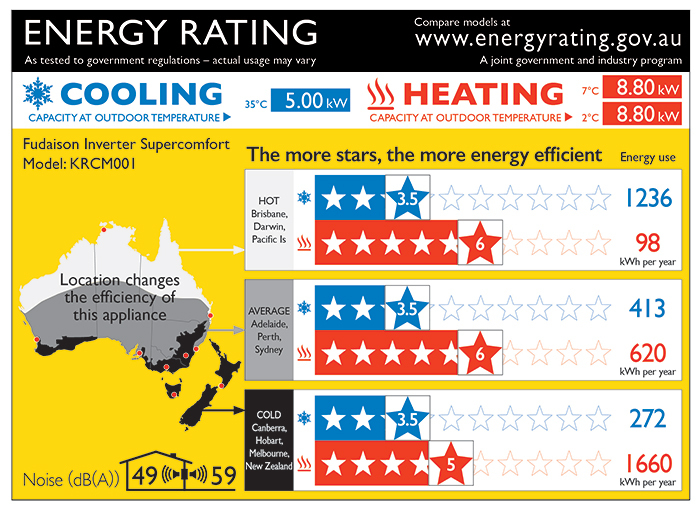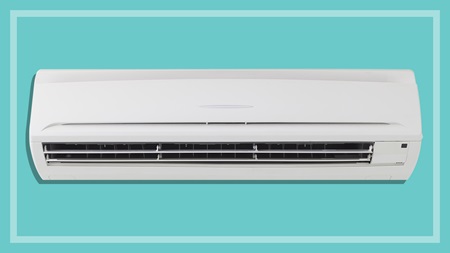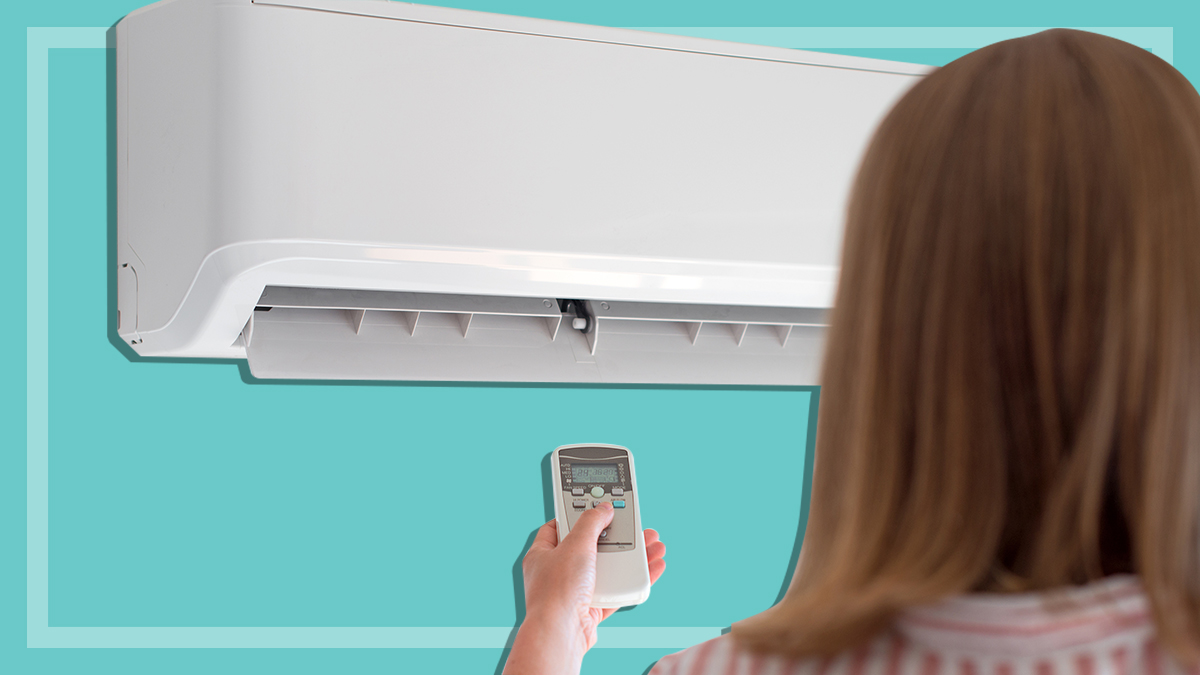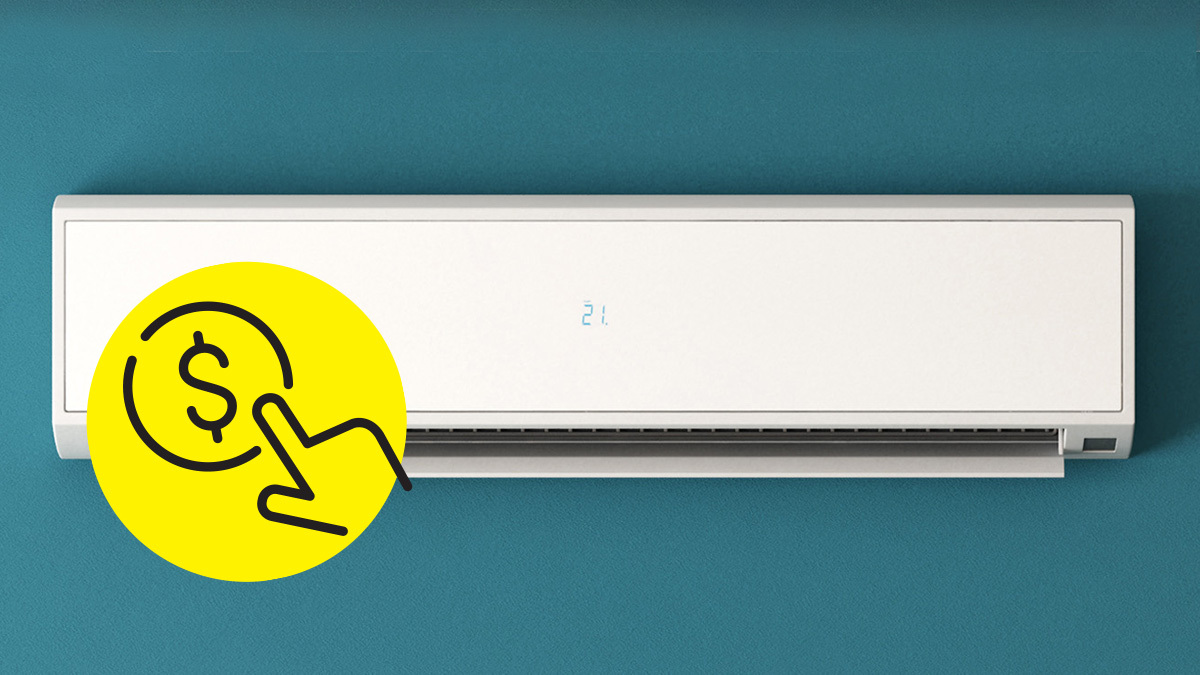Get our independent lab tests, expert reviews and honest advice.
How to choose an energy-efficient air conditioner

Need to know
- The first step in choosing an energy-efficient air conditioner is picking the correct size for your home
- Look at the star rating label and CHOICE reviews to find an air conditioner that delivers the most cooling and heating for the least electricity
- Knowing what temperature to set, using the right features and keeping your air conditioner well-maintained can help you get the best results
On this page:
- What makes a more efficient air conditioner?
- Choosing the right size (cooling/heating capacity)
- Star rating labels
- Features and specifications that can improve efficiency
- Using and maintaining your air conditioner
- What's the most efficient type of air conditioner?
Air conditioners are a common feature in Australian homes, and for good reason – most of Australia faces hot summers, and many areas have cold winters too. That’s one reason why heating and cooling typically accounts for about 40% of our energy bills.
But while a split-system air conditioner is one of the most energy-efficient appliances for cooling and heating your home, the installation and running costs can still be daunting – they aren’t all built the same, or intended for the same types of rooms. You might also be considering a portable air conditioner. We’ll take you through the key steps in choosing an air conditioner that will be the most effective and energy-efficient for your needs and your home.
What makes a more efficient air conditioner?
Put simply, the efficiency of an air conditioner is based on how much cooling or heating it can deliver compared to how much electricity it uses to do it. The more cooling or heating, and the lower the electricity consumption, the more efficient the air conditioner.
Star rating labels are a simple way to compare comparative efficiency between models of the same size or capacity
The larger the air conditioner (in terms of its cooling or heating capacity in kilowatts, not its physical size), the less efficient it tends to be. That’s unfortunately just the nature of how the refrigerant and compressor technology works; it takes comparatively more electricity usage to deliver a large amount of heating or cooling.
A large 8kW unit won’t generally achieve the same energy efficiency as a small 2.5kW unit, and these shouldn’t be directly compared against each other. Of course, it’s not just about their comparative energy efficiencies – the 8kW can cool or heat a much bigger space than the 2.5kW model. That leads us to the first step in choosing an efficient air conditioner: getting the correct size for the room.
Choosing the right size (cooling/heating capacity)
When you’re investing in an air conditioner, it can be tempting to think that the bigger the system, the better. Or conversely, you might decide to save some money and buy a small air conditioner. But either way can be a false economy. It’s important to get the correct sized unit for the room.
An air conditioner’s size, or capacity, is a measure of how much cooling or heating it can deliver, and is measured in kilowatts (kW). A small unit might be 2.5kW and suited to a bedroom; a medium unit could be 5kW and suited to a living room; a large unit could be 6kW or more, and suited to a large open-plan living and dining area.
What happens if the air conditioner is the wrong size for the room?
If the air conditioner is too big for the room, it may run frequent short cycles to achieve the target temperature. This can mean the room gets too hot or cold, the air isn’t dehumidified enough (so the room feels less comfortable), and the power usage and running costs go up. It also means more wear and tear on the system.
If the air conditioner is too small, it may have to run at maximum output more often. This can mean the unit dries out the air too much, there’s more wear and tear on the system, and again the power use and running cost increases.
So you can see that even if the air conditioner’s rated efficiency is excellent, it could be wasted if it’s put into the wrong sized room.
A good installer will calculate the right size for your room, or you can do it yourself.
Star rating labels
Residential split-system air conditioners have to meet minimum energy performance standards (MEPS) to be sold in Australia. This means you can be assured that any new model you buy will be reasonably energy-efficient.
When a manufacturer registers a model with the government Energy Rating system, the air conditioner gets a star rating label for cooling and heating based on its test results against the Australian standard for air conditioners. You’ll see the label on the model in shops or online. This gives you a quick and easy way to compare models.
Star rating labels are a simple way to compare comparative efficiency between models of the same size or capacity. The more stars, the more efficient the model and the less it should cost to run, assuming it’s been correctly installed.
Aim to set your unit around 8°C cooler than the outside temperature – you’ll still be comfortably cool and it’ll cost you less
Even a model with one or two stars is still OK, but a model with five or six stars (or more) is clearly better. The more efficient model might also be more expensive, though.
Any new model registered from April 2020 onwards has a new star rating label, known as the Zoned Energy Rating Label (ZERL). This shows three cooling star ratings and three heating star ratings based on the climate zone where the unit is installed.
An air conditioner that’s good at cooling a home in an average climate zone (see below) might not be the best choice for someone living in a hot zone, for example. Likewise, others might be best suited to heating homes in cold zones. These zone ratings help you choose the best model for your area and your needs.
The three climate zones are:
- hot – northern Australia, including Darwin and Brisbane
- average – the middle zone of Australia, including Sydney, Adelaide and Perth
- cold – southern Australia, including Melbourne, southern Western Australia, Tasmania, Canberra and eastern state mountain regions, and also New Zealand.
Using CHOICE reviews
Our air conditioner reviews score each model for cooling and heating efficiency.
We score cooling efficiency based on each air conditioner’s rated Annual Energy Efficiency Ratio (AEER), a measure of how much cooling the model delivers for the electricity it uses, plus standby and other non-operating power consumption. The heating efficiency score is based on the air conditioner’s rated Annual Coefficient of Performance (ACOP), a similar measure for heating energy delivery.
Look for a model with good cooling and heating scores, but it’s still worth also checking its zoned star ratings to make sure it suits the climate zone you live in.

Features and specifications that can improve efficiency
Here are a few features to look for that may help you run your air conditioner more efficiently.
Human presence sensor
This detects whether someone is in the room, so the unit knows to keep working. When no one is detected, the unit might switch to an economy mode to reduce power consumption (but you should still turn the unit off if the house is empty).
Wi-Fi and app control
Many newer models can connect to the wireless network in your home so you can control the air conditioner via an app on your smartphone – handy if you’re at work and want to turn it on before you get home, or you’re at home and you’ve misplaced the remote.
It may be more efficient to turn on your air conditioner remotely on a milder setting and let it work for an hour or so to cool or heat the room, rather than turning it onto full blast when you get home in an effort to quickly get the room comfortable. It could also save on costs if you realise that you left the air conditioner running when it’s not needed, and you can turn it off remotely.
Demand Response Enabling Device (DRED)
If you have an air conditioner with the Demand Response Enabling Device (DRED, or PeakSmart) feature, and your energy provider offers the PeakSmart service, they’ll be able to remotely switch your air conditioner to an economy mode during times of high demand on the grid.
This will usually have no major impact on the air conditioner’s cooling (or heating) output – you might not even notice it happening – but it will reduce the amount of power the air conditioner is using, not just saving you money but also reducing the need for more ‘poles and wires’ to meet energy needs.
So far only a few energy companies provide the service. Some energy companies, including Queensland-based Energex and Ergon, also pay incentives to customers who buy DRED-enabled air conditioners.
Using and maintaining your air conditioner
Here are some tips for running your air conditioner most efficiently.
- Aim to set your unit around 8°C cooler (or warmer, in heating mode) than the outside temperature. So if it’s 33°C outside and you’re craving a cool blast, try to settle for 25°C instead of running your room at 18°C. You’ll still be comfortably cool and it’ll cost you less. It will also save on wear and tear on the air conditioner’s motor.
- Of course, on extreme days you’ll probably want to go beyond an 8°C difference. Just try to keep the difference to the smallest amount that you can. In general, each degree cooler (or warmer in winter) usually adds about 10% to the running cost of your air conditioner.
- Consider using the fan-only mode if the indoor air isn’t too hot.
- Try the “dry mode” if it has one. This is a dehumidifying mode that’s good for moderately warm but humid days.
- On very hot (or very cold) days, seal the house up and turn the air conditioner on earlier, so it can get the indoors to a comfortable temperature and maintain it before the outdoor temperature gets too extreme.
Maintaining your air conditioner
Keeping the air conditioner in good condition will help it run more efficiently and effectively. Regularly clean the air filters and keep an eye on how its performing (some DIY air conditioner maintenance will help keep the unit running smoothly). A professional service every few years is also worth considering.
What’s the most efficient type of air conditioner?
There are four main types of air conditioner used in Australia.
- Split-systems: An indoor unit and an outdoor unit connected by pipes containing refrigerant gas. They’re the most common air conditioner type in Australia, and are good for a room or open-plan area up to about 60m2.
- Wall/window: A single box unit, installed in a window or through an external wall. They’re good for rooms and open-plan areas of up to 50m2. Smaller units can be plugged into a normal power point while larger ones may need additional wiring.
- Ducted: A central unit, usually located out of sight in your roof or outdoors, connected by air ducts to air outlets and sensors in each room throughout the house.
- Portable: Single units that can be moved from room to room as needed (but generally not easily). Most have a flexible duct that must be attached to a window to vent the heat outside. Portable air conditioners are sometimes the only option for rooms in households where a built-in option isn’t feasible (such as if you’re renting).
In most cases, a split-system is the most energy-efficient option. That’s down to its design – the separate outdoor compressor is connected only by sealed copper pipes (containing refrigerant gas) to the indoor unit. There’s no actual air exchange between the two units, only a heat exchange. As long as the room is well insulated and sealed, all the heating or cooling energy goes directly into the indoor air.
Ducted systems share most of the advantages of split-systems, but the air ducts from the central unit to each room must be well sealed and made from the right material, otherwise air loss and inefficiencies can happen.
Wall/window units can be reasonably efficient when installed correctly but generally can’t match a split-system.
Portable air conditioners are a convenient solution when there’s no option to install a split-system, but just can’t be as effective or efficient. They draw the air from the room (in order to cool it) and vent the hot air outside through the duct. This results in a net air pressure reduction, so more warm air is drawn into the room from the rest of the house. The portable air conditioner thus faces a continual struggle to cool the room.






